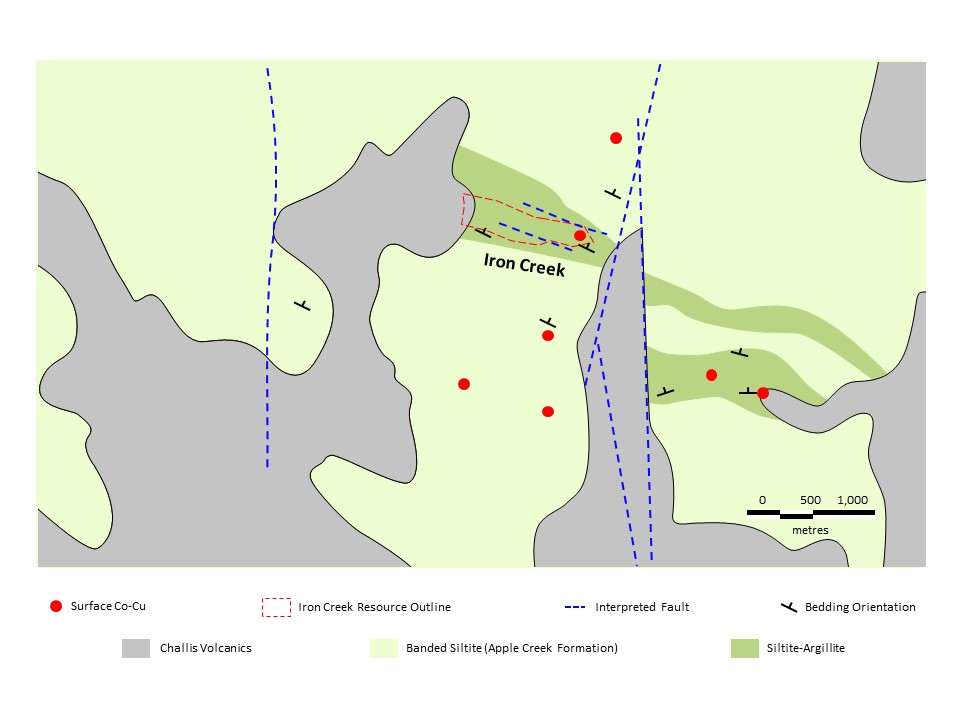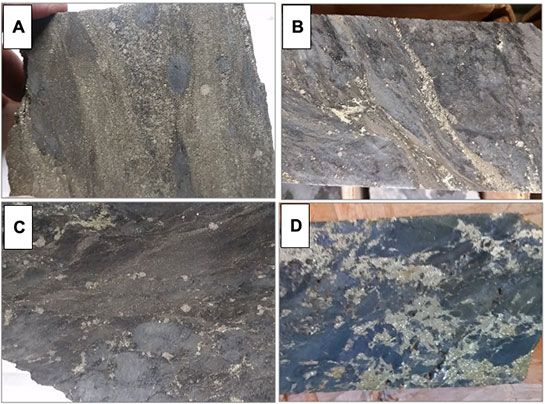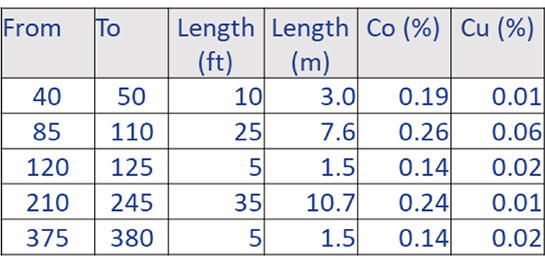Idaho Property Geology
Bedrock mapping was conducted on the Property and beyond by Noranda in 1971 as part of their exploration throughout the Idaho Cobalt Belt. Systematic mapping has not been done recently but some areas previously mapped have been validated (Figure 1).
In general, the metasedimentary rocks that host the Iron Creek cobalt-copper mineralization are fine grained, interbedded siliciclastic rocks. Bedding is relatively steep; 60-80o dipping toward the northeast. The host metasedimentary rocks are part of the Apple Creek Formation within the Belt Supergroup considered Meso-Proterozoic in age.
Overall, the metamorphic grade is lower greenschist facies such that most of the primary grain size and sedimentary textures have been preserved.
The clastic rocks range in grain size from mudstone (argillite) to sandstone (quartzite), but the dominant rock type is siltstone (siltite). Individual beds are identified by distinct color variations that reflect both grain-size and compositional variations. In places, individual beds are calcareous, recognized by metamorphic siderite porphyroblasts.
Carbonate-rich rocks, such as limestone or dolostone, are generally absent in the sequence at the Iron Creek project and surrounding area.
Overall, quartzite beds are relatively thin (<50cm). “Quartzite” is defined in drill core as strata with meta-sandstone interbeds of greater than 2 inches.
The host rocks to cobalt-copper sulphide mineralization are particularly argillaceous and are found as discrete lithological units throughout the Property. Within the Iron Creek area, mineralization occurs where quartzite units are regularly interbedded with argillite.
In general, deformation in the area drilled at Iron Creek is minor; based on the continuity of individual lithological units and only minor offset on thin mafic dykes that cross-cut mineralization. Two sets of faults occur at the property-scale: one set trends west-northwest and roughly parallel to sedimentary bedding and the second set is known regionally and strikes north and east-northeast. These faults are interpreted as normal with displacement down toward the east.
Figure 1. Simplified bedrock geology map of the Idaho Property.
Mineralization
- Mineralization conforms to the bedding in the host metasedimentary rocks generally striking north-northwest and dipping between 60° and 80° northeast.
- The primary mineral assemblage consists of pyrite, chalcopyrite, pyrrhotite, and magnetite.
- Pyrite is the most abundant and widespread. Pyrite varies from massive to blebby, and from coarse-grained disseminated crystals to very fine-grained patches and disseminations. Coarse pyrite (cm-sized grains) form as porphyroblasts due to recrystallization.
- Chalcopyrite varies from streaks and wisps to large blebs, is entirely anhedral to subhedral, and occurs intergrown with pyrite and pyrrhotite when the minerals are observed together. Higher grade copper occurs in the west as large blebs and stringers discordant to the metasedimentary strata.
- Typically but not exclusively, the distribution of sulfide and magnetite mineralization is coincident with zones of moderate to intense shearing.
Mineralization Textures at Iron Creek
- Semi-massive pyrite; high grade cobalt
- Pyrite sheared along bedding planes
- Fine grained pyrite cut by chalcopyrite
- Chalcopyrite in high-grade Cu zone
Ruby Zone
- Cobalt-copper mineralization well exposed along timber road in southern portion of property
- Similar siltite host rock to Iron Creek
- Channel sampling completed across 152m (500ft) strike extension
- Individual samples 1.5m (5ft) up to 0.48% Co (230 to 235ft)
- Likely separate stratigraphic horizon or fault offset to Iron Creek
CLICK HERE FOR Iron Creek Technical Report
Drilling Highlights 2018-2019 and Resource Cross Sections
Click here for Drilling Highlights 2018-2019
and Resource Cross Sections




